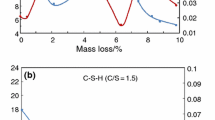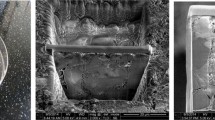Abstract
The dynamic mechanical properties of compacted samples of synthetic calcium silicate hydrate (C–S–H) were determined at variable stoichiometries (C/S ratio). The stiffness and damping properties of the C–S–H systems were monitored at various increments of mass loss from 11%RH following the removal of the adsorbed and interlayer water. The changes in the storage modulus (E′) and internal friction (tan δ) were discussed in terms of the state of water present in the nanostructure of C–S–H, the evolution of the silicate structure and the interaction of calcium ions in the interlayer region. Results were compared to those for the hydrated Portland cement paste and porous glass. It was shown that the C–S–H in the hydrated Portland cement has a complex yet analogous dynamic mechanical behavior to that of the synthetic C–S–H. The response of these systems upon the removal of water was explained by a layered model for the C–S–H. A mechanistic model was proposed to describe the changes occurring at various stages in the dynamic mechanical response of C–S–H.







Similar content being viewed by others
Notes
Cement chemistry nomenclature: C = CaO, S = SiO2 and H = H2O. Dashes indicate that no specific stoichiometry is implied.
References
Ciach TD, Gillott JE, Swenson EG, Sereda PJ (1971) Microstructure of calcium silicate hydrates. Cem Concr Res 1:13–25
Constantinides G, Ulm F-J (2007) The nanogranular nature of C–S–H. J Mech Phys Solids 55:64–90
Ramachandran VS, Feldman RF, Beaudoin JJ (1981) Concrete science: treatise on current research. Heydon & Son Ltd., London, p 427
Feldman RF (1972) Factors affecting the Young’s modulus—porosity relation of hydrated Portland cement compacts. Cem Concr Res 2(4):375–386
Feldman RF (1968) Sorption and length-change scanning isotherms of methanol and water on hydrated Portland cement. In: Proceedings of the 5th international symposium on the chemistry of cement, vol 3. Tokyo, Japan, pp 53–66
Odelson JB, Kerr EA, Vichit-Vadakan W (2007) Young’s modulus of cement paste at elevated temperatures. Cem Concr Res 37:258–263
Taylor HFW (1997) Cement chemistry, 2nd edn. Thomas Telford, London
Beaudoin JJ, Feldman RF (1986) Dependence of degree of silica polymerization and intrinsic mechanical properties of C–S–H on C/S ratio. In: 8th international congress on the chemistry of cement, Rio de Janeiro, Brazil, vol 3, pp 337–342
Constantinides G, Ulm F-J (2004) The effect of two types of C–S–H on the elasticity of cement-based materials: results from nanoindentation and micromechanical modeling. Cem Concr Res 34:67–80
Constantinides G, Ulm F-J, Van Vliet K (2003) On the use of nanoindentation for cementitious materials. Mater Struct 36(3):191–196
Plassard C, Lesniewska E, Pochard I, Nonat A (2004) Investigation of the surface structure and elastic properties of calcium silicate hydrates at the nanoscale. Ultramicroscopy 100:331–338
Steinour HH (1954) The reactions and thermochemistry of cement hydration at ordinary temperature. In: 3rd international symposium on the chemistry of cements, pp 261–289
Pellenq RJ-M, Gmira A, Van Damme H (2007) Stability and elastic properties of tobermorite, a model of cement hydrate at the nano-scale. MS&T’07, Advances in cement-based materials, Detroit, Michigan, 1–12 September 2007
Hamid SA (1981) The crystal structure of the 11 Å natural tobermorite Ca2.25[Si3O7.5(OH)1.5]·1H2O. Z Kristallogr 154:189–198
Merlino S, Bonaccorsi E, Armbruster T (1999) Tobermorites: their real structure and OD character. Am Mineral 84:1613–1621
Gmira A, Zabat M, Pellenq RJ-M, Van Damme H (2004) Microscopical basis of the poromechanical behaviour of cement-based materials. Mater Struct 37:3–14
Manzano H, Dolado JS, Guerrero A, Ayuela A (2007) Mechanical properties of crystalline calcium-silicate-hydrates: comparison with cementitious C–S–H gels. Phys Status Sol A 204(6):1775–1780
Pellenq RJ-M, Van Damme H (2004) Why does concrete set? The nature of cohesion forces in hardened cement-based materials. MRS Bull 29(5):319–323
ASTM D 5023-01 “Standard test method for plastics: dynamic mechanical properties: in flexure (three point bending),” American Society for Testing and Materials
ISO 6721-5, Plastics-determination of dynamic mechanical properties—part 5: flexural vibration-Non-resonance method. International Organization for Standardization
Feldman RF, Ramachandran VS (1974) A study of the state of water and stoichiometry of bottle-hydrated Ca3SiO5. Cem Concr Res 4(2):155–166
Sereda PJ, Feldman RF (1963) Compacts of powdered material as porous bodies for use in sorption studies. J Appl Chem 13:150–158
Beaudoin JJ (1983) Comparison of mechanical properties of compacted calcium hydroxide and Portland cement paste systems. Cem Concr Res 13:319–324
Soroka I, Sereda PJ (1968) “The Structure of Cement-stone and the Use of Compacts as Structural Models.” 5th International Symposium on the Chemistry of Cement, Tokyo, 67–73
Sereda PJ, Feldman RF, Swenson EG (1966) Effect of sorbed water on some mechanical properties of hydrated Portland cement pastes and compacts. Highway Research Board, Special Report 90:58-73
Menard KP (1999) Dynamic mechanical analysis—a practical introduction. CRC Press LLC, Boca Raton, p 208
Carde C, François R (1997) Effect of the leaching of calcium hydroxide from cement paste on the mechanical and physical properties. Cem Concr Res 27(4):539–550
Manzano H, Dolado JS, Ayuela A (2009) Elastic properties of the main species present in Portland cement pastes. Acta Mater 57:1666–1674
Grutzeck M, Benesi A, Fanning B (1989) Silicon-29 magic-angle spinning nuclear magnetic resonance study of calcium silicate hydrates. J Am Ceram Soc 72:665–668
Klur I, Pollet B, Virlet J, Nonat A (1998) C–S–H structure evolution with calcium content by multinuclear NMR. In: 2nd international conference on NMR spectroscopy of cement based materials, pp 119–141
Garbev K, Stemmermann P, Black L, Breen C, Yarwood J, Gasharova B (2007) Structural features of C–S–H(I) and its carbonation in air—a Raman spectroscopic study. Part I: fresh phases. J Am Ceram Soc 90(3):900–907
Nonat A, Lecoq X (1998) The structure, stoichiometry and properties of C–S–H prepared by C3S hydration under controlled condition. In: Colombet P, Grimmer AR, Zanni H, Sozzani P (eds) NMR spectroscopy of cement based materials. Springer, Berlin, pp 197–207
Alizadeh R, Beaudoin JJ, Ramachandran VS, Raki L (2009) Applicability of Hedvall effect to study the reactivity of calcium silicate hydrates. J Adv Cem Res 21(2):59–66
Helmuth RA, Turk DH (1966) Elastic moduli of hardened Portland cement and tricalcium silicate pastes: effect of porosity. In: Symposium on structure of Portland cement paste and concrete (special report 90), Highway Research Board, Washington, DC, pp 135–144
Knudesn FP (1959) Dependence of mechanical strength of brittle polycrystalline specimens on porosity and grain size. J Am Ceram Soc 42(8):376–387
Nielsen LF (1984) Elasticity and damping of porous materials and impregnated materials. J Am Ceram Soc 67(2):93–98
Beaudoin JJ, Feldman RF, Tumidajski PJ (1994) Pore structure of hardened Portland cement pastes and its influence on properties. Adv Cem Based Mater 1:224–236
Beaudoin JJ, Feldman RF (1975) A study of mechanical properties of autoclaved calcium silicate systems. Cem Concr Res 5:103–118
Radjy F, Richards CW (1973) Effect of curing and heat treatment history on the dynamic mechanical response and the pore structure of hardened cement paste. Cem Concr Res 3:7–21
Sellevold EJ, Radjy F (1976) Drying and resaturation effects on internal friction in hardened cement pastes. J Am Ceram Soc 59(5–6):256–258
Radjy F, Richards CW (1969) Internal friction and dynamic modulus transitions in hardened cement paste at low temperatures. Mater Struct 2(7):17–22
Evans RH, Marthe MS (1968) Microcracking and stress-strain curves for concrete in tension. Matériaux et Constractions 1:61–64
Parrott LJ (1973) The effect of moisture content upon the elasticity of hardened cement paste. In: Proceedings of the fifth international symposium on the chemistry of cement, Tokyo, vol 3, pp 1–32
Haque MN, Cook DJ (1976) The effect of water sorption on the dynamic modulus of elasticity of desiccated concrete materials. Mater Struct 9(6):407–410
Powers TC, Brownyard TL (1946) Studies of the physical properties of hardened Portland cement paste—part 3: theoretical interpretation of adsorption data. J Am Concr Inst 18(4):469–504
Young JF (1988) Investigations of calcium silicate hydrate structure using silicon-29 nuclear magnetic resonance spectroscopy. J Am Ceram Soc 71(3):C118–C120
Yu P, Kirkpatrick RJ (1999) Thermal dehydration of tobermorite and jennite. Concr Sci Eng 1:185–191
Sato H, Grutzeck M (1992) Effect of starting materials on the synthesis of tobermorite. Mater Res Soc Symp Proc 245:235–240
Van Damme H, Gmira A (2006) Cement hydrates. In Bergaya F, Theng BKG, Lagaly G (eds) Chapter 13.3 in Handbook of clay science. Elsevier, Amsterdam, p 1246
Pellenq RJ-M, Lequeux N, Van Damme H (2008) Engineering the bonding scheme in C–S–H: the iono-covalent framework. Cem Concr Res 38:159–174
Alizadeh R (2009) Nanostrcuture and engineering properties of basic and modified calcium-silicate-hydrate systems. PhD thesis, Department of Civil Engineering, University of Ottawa, p 231
Seligma P (1968) Nuclear magnetic resonance studies of the water in hardened cement. J Portland Cem Assoc Res Dev Lab 10(1):52–65
Morlat R, Godard P, Bomal Y, Orange G (1999) Dynamic mechanical thermoanalysis of latexes in cement paste. Cem Concr Res 29:847–853
Foray-Thevenin G, Vigier G, Vassoille R, Orange G (2006) Characterization of cement paste by dynamic mechanical thermo-analysis. Mater Charact 56:129–137
Feldman RF, Sereda PJ (1968) A model for hydrated Portland cement paste as deduced from sorption-length change and mechanical properties. Matériaux et Construction 1(6):509–520
Jennings HM (2008) Refinements to colloid model of C–S–H in cement: CM-II. Cem Concr Res 38:275–289
Cong X, Kirkpatrick RJ (1996) 29Si MAS NMR study of the structure of calcium silicate hydrate. Adv Cem. Based Mater 3:144–156
Richardson IG, Groves GW (1992) Models for the composition and structure of calcium silicate hydrate (C–S–H) gel in hardened tricalcium silicate pastes. Cem Concr Res 22:1001–1010
Taylor HFW (1986) Proposed structure for calcium silicate hydrate gel. J Am Ceram Soc 69(6):464–467
Acknowledgement
Authors would like to acknowledge the financial support from NSERC and the technical advice from Ms. Ana Delgado for the DMA analysis.
Author information
Authors and Affiliations
Corresponding author
Rights and permissions
About this article
Cite this article
Alizadeh, R., Beaudoin, J.J. & Raki, L. Mechanical properties of calcium silicate hydrates. Mater Struct 44, 13–28 (2011). https://doi.org/10.1617/s11527-010-9605-9
Received:
Accepted:
Published:
Issue Date:
DOI: https://doi.org/10.1617/s11527-010-9605-9




